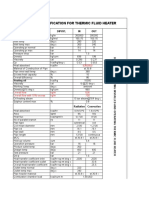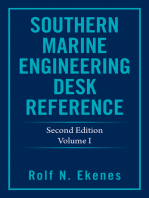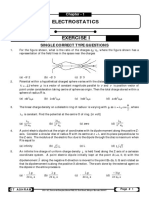Bemco Steel Industries Co. LTD.: Qp10-Q-6764 - Typicalsteelwatertower1500M
Bemco Steel Industries Co. LTD.: Qp10-Q-6764 - Typicalsteelwatertower1500M
Uploaded by
hgagCopyright:
Available Formats
Bemco Steel Industries Co. LTD.: Qp10-Q-6764 - Typicalsteelwatertower1500M
Bemco Steel Industries Co. LTD.: Qp10-Q-6764 - Typicalsteelwatertower1500M
Uploaded by
hgagOriginal Title
Copyright
Available Formats
Share this document
Did you find this document useful?
Is this content inappropriate?
Copyright:
Available Formats
Bemco Steel Industries Co. LTD.: Qp10-Q-6764 - Typicalsteelwatertower1500M
Bemco Steel Industries Co. LTD.: Qp10-Q-6764 - Typicalsteelwatertower1500M
Uploaded by
hgagCopyright:
Available Formats
BEMCO STEEL INDUSTRIES CO. LTD.
DESIGN CALCULATIONS
CLIENT
PROJECT QP10-Q-6764_TypicalSteelWaterTower1500m³
Rev. Description Prepared
Reviewed
Approved Date
0 Mechanical Calculation H.M H.M M.B 25/2/2013
1- FOR INFORMATION ONLY
2- FOR APPROVAL
3- FOR CONSTRUCTION
Design. Ref.Decuments
API 650 ,11TH.ED
M09
1 EVALUATION OF MATERIAL API650 -5.6.2 Tabel5-2a
2 EVALUATION OF SHELL THK. API650 -Clause 5.6.3.2
3 EVALUATION OFBOTTOM PLATE API650 -Clause 5.5
4 EVALUATION OFBOTTOM SKETCAPI650 - Clause 5.4
5 EVALUATION OF ROOF THICKNEAPI650- Clause5.10.4 & 5.10.5
6 STABILITY CHECK AGAINST WIN API650 - Clause 5.9.7.1
7 SHELL TRANSFORMER API650- Clause 5.9.7.2
8 WIND GIRDER STIFFENING API650- Clause5.9.5
9 OVERTURNING MOMENT AGAINSAPI650-Clause 5.11.1
WIND LOAD
10 UNANCHORED TANKS STABILITYAPI 650 -5.11.2
11 STABILITY CHECK SEISMIC API650-APPENDIX E
12 VENT SIZE CALC. API650-Clause -API2000
13 REINF. AROUND OPENING API650-Clause5.7
BOTTOM & ANNULAR PLATE DESIGN
3 .0 BOTTOM PLATE & ANNULAR PLATE DESIGN
Annular plate used ? ( yes/no ) NO
BOTTOM PLATE
(i) Minimum thickness as per API 650 Clause 5.4.1 = 6.00 mm
Minimum thickness required ( #REF! mm c.a ) = #REF! mm
Therefore, use thickness of 16.00 mm (tb) is #REF!
(iv) Min. width of plate (cl. 5.4.1) = 1800 mm
Botom PLATE
(i) Nominal thickness of 1st shell course, tsc1 = #REF! mm
Hydro. test stress in 1st shell course,
4.9Dn(H-0.3) = #REF! N/mm²
St =
tsc1
where
Dn = Nominal diameter, Dn ( new ) ( based on 1st shell course )= #REF! m
H = Design liquid level = #REF! m
tsc1 = Nominal thickness of 1st shell course = #REF! mm
Annular plate thickness ( As per Table 5-1a ) = #REF! mm
Minimum thickness required ( #REF! mm c.a. ) = #REF! mm
Therefore , use thickness of 16.00 mm (ta) is #REF!
(ii) Min. shell-to-bottom fillet welds size (cl. 5.1.5.7) = #REF! mm
(iii) Min. width projected inside of shell to edge of overlapping (cl. 5.5.2) = 600 mm
(iv) Min. radial width of annular plate (cl. 5.5.2)
215 ta
La = = #REF! mm
(HL. SG )0.5
where
ta = Annular plate thickness = 16.000 mm
HL = Maximum design liquid level = #REF! m
SG = Design specific gravity = #REF!
(v) Min. width projected outside of shell ( cl. 5.5.2)(50 mm) = 50 mm
AW1, Width projected inside of shell to edge of overlapping = 600 mm
AW2,Width projected outside of shell = 70 mm
tsc1 Nominal thickness of 1st shell course = #REF! mm
Width of Annular Ring Max.{ (AW1+AW2+tsc1) & La} = #REF! mm
Width of Annular Ring provided = 700 mm
Annular Ring outside diameter = #REF! mm
Annular Ring inside diameter = #REF! mm
Outer Diameter of Bottom Plates = #REF! mm
We will Use Bottom witout Anular
11 HEATING COIL Reff. Pressure Vessel Manual,procedure 6-8 & ASME
Heater Sketch as per Data sheet
Coil Development Length 436 m
4 group coils each group 109 m
Average Pipe Length 12 m
Total pipes 36 pipe
Heater w,t 15,816 kg
Pipe supportes approx. 7000 kg
Total w,t 22,816 kg
` Product
Product in
1.0
Stem in
Condensate
Steam Coil Data
1.1 Operating Pressure 4 ata
1.2 Pressure at inlet of Coil heater 4 ata
1.3 Steam temp.at design pressure of coil 168 0
C
1.4 Design Pressure 4 ata
1.5 Latent heat at inlet pressure,hfg 509.43 Kcal/kg ( Note-1)
2 Asphalt Data
2.1 type FUEL OIL
2.2 Density at low temp. ,D1 950 kg/m3
2.3 Specific Heat ,Cp1H 0.48 K cal/Kg 0C ( Note-2)
2.4 initial Temp., (Minim.Ambient Air Temp.),,T1 5 0
C
2.5 Final Temp.(Fuell Temp.to be maintained) ,T2H 110 0
C
2.6 Average Temp. ...,Tav = (T1+T2H) / 2 57.5 0
C
3 Tank insulation Material
3.1 Type LRB Mineral Wool (IS8183)
3.2 Density of the material 100 kg/m3
3.3 Cladding Material Aluminium ,22 SWG
4 Process Requirment Data
4.1 Volume of Liquid to be Heated ,V 2219.65 m3
4.2 Heating time ,Ht 72 hr ( Note-3)
4.3 Mass of Liquid to be Heated ,M1H =V*D1 2,108,668 m3
5 Heat Thermal Load Calculations
5.1 Temp. difference during intial heating of Fuel ,Dt =T2H- T1 105 0
C
5.2 Heat Load For intial Heating of Product,Q1=M1H*Cp1H*D 1476067.25 Kcal/hr
6 Heat Loss through Tank Shell ,Bottom, Roof During Intial Stage
6.1 Heat Loss through Tank Shell for Product if Tank Fully insulated
a Tank , D(Tank inner Dia.) 16 m
b Tank , h(Tank height ) 12 m
c Average thickness of tank shell without insulation t s 7 mm
d Average thickness insulation , t in 40 mm
e Outer Dia.of Tank shell without Insulation, Ds 16.0140 m
f Outer Diameter Of Insulation ,Din 16.0940 m
g Thermal conductivity of insulation ,Ki 0.043 W/cm 0C ( Note-4)
H Thermal conductivity of insulation ,Ki 0.0369800 kcal/hr m 0C
I Film Co-efficient, (Refer calc. at end),f 6.1774 kcal/hr m2 0C
J Average Temp.difference during intial heating of Fuel
K ∆Tav.= T2H-Tav. 52.5 0
C
L Rate of heat Loss through Tank Shell,QL
M qL =∆Tav./ [ ( Ds /2ki) * ln (Din/Ds) + (Ds/ f * Din) ] 42.3370870445144 kcal/hr m2 ( Note-5)
N Shell surface area ,As 603.713577055043 m2
S Heat Loss through Tank Shell ,Q2 =(qL*As) 25559.4742617345 kcal/hr
6.2 Heat Loss through Roof of Tank (insulated)
a Insulation Thickness Considered ,tr 40 mm
b Thermal Conductivity of the insulation,Ki 0.0369800 kcal/hr m 0C
c Film Co-efficient,(Refer
f calc. at end) 6.1774 kcal/hr m2 0C
d Average Temp.for heat loss during intial heating , Tav. 57.5 0C
e Average Temp.difference during intial heating of Fuel
f ∆Tav.= T2H-Tav. 52.5 0C
g Rate of heat loss through Roof ,q r=∆Tav/[ (tr/ki)+(1/f)] 42.2180128201183 kcal/hr m2
g Roof Diameter ,RD ( Development) 16.08 m
h Surface area of Roof ,Ar 203.07757567629 m2
i Heat Loss through roof QLr =qr*Ar 8573.53169338015 Kcal/hr
7 Heat Loss through Bottom of Tank
a Surface area of Bottom of Tank,Ab 201.061929829747 m2
b Theraml Conductivity of Sand ,Ks 1 W/Mk
c Theraml Conductivity of Sand ,Ks 0.85999999828 kcal/hr m 0C
d Average temp.difference during initial heating of Fuel ,
e ∆Tav.= T2H-Tav. 52.5 0C
f Depth of sand bed ,X 1m
j Heat Loss Through Bottom Plates ,QB=(Ab*Ks* ∆Tav.) / X 9077.94611365718 kcal/hr
8 Heat Loss through Tank shell&Bottom&Roof During Shutt down /Manintenance (insulated)
a Tank inner Diameter ,Di 16 m
b Tank outer Diameter without insulation,Do 16.014 m
c Tank outer Diameter with insulation ,Doi 16.094 m
d Height of Tank shell ,h 12 m
e Thermal Conductivity of insualtion ,Ki 0.0369800 kcal/hr m 0C ( Note-6)
f Film Co-efficient .f (Refer calc.at end) 6.1774 kcal/hr m2 0C
g Temp.diff. During Maintenance /Shutt down , ∆T=T2H -T1 105 0C
h Rate of heat loss through Tank shell
j q m = ∆T /[ ( Do/2* Ki) * ln (Doi/Do) + (Do/Doi*f) ] 84.6741740890288 kcal/hr m2 ( Note-7)
k Shell surface Area ,As 603.449683272142 m2
l Heat Loss Through Tank Shell ,Qsm=As*qm 51096.6035353546 kcal/hr
9 Heat Loss through Roof of Tank (insulated)
a Insulation thickness Considered ,tir 40 mm
b Theraml Conductivity of the insulation ,Ki 0.0369800 kcal/hr m 0C
c Film Co-efficient .f (Refer calc.at end) 6.1774 kcal/hr m2 0C
d Temp.diff. During Maintenance /Shutt down , ∆T=T2H -T1 105 0C
e Rate of heat Loss through Roof during Main./shutdown,q r
f q r=∆T / [ ( tir / ki) + ( 1 / f) ] 84.4360256402365 kcal/hr m2
g Roof Diameter,Dr 16.08 m
h Surface area of Roof ,Ar 203.07757567629 m2
j Heat Loss through roof /Main./shutt down ,Q rfm =Ar *qr 17147.0633867603 kcal/hr
10 Heat Loss through Bottom Plates during Maintenance/Shutdown
a Surface area of Bottom Plates,Abm 201.061929829747 m2
b Theraml Conductivity of Sand ,Ks 0.85999999828 kcal/hr m 0C
c Temp.diff. During Maintenance /Shutt down , ∆T=T2H -T1 105 0
C
d Depth of sand bed ,X 1 m
e Heat Loss Through Btm Plates ,QBm=(Abm*Ks* ∆Tav.) / X 18155.8922273143 kcal/hr
11 HEAT REQUIRED PER HOUR TO HEAT TANK MATERIAL UP TO 110 0
C
a Product weight to be Heated ,M2 73460 kg
b Specific Heat of Product ,Cp2 0.502 kj /(kg 0c)
c Specific Heat of Product ,Cp2 0.12 kcal/(kg 0c)
d Temp.difference during intial heating ,∆T=T2H -T1 105 0
C
e Heating Time ,Ht 72 hr
f Heat req. for pumping in/out of asphalt Mass(M2) Qp=M 2Cp2∆T / Ht 12855.5 kcal / hr
12 TOTAL HEAT LOAD / HOUR
Intermittent heat load / Tank (for intial heating of Fuel
a Qint =Heat rate required forintial heating+Heat rate req.for product pumping(in/out)+Heat Loss
Qint= ( intermittent) = Q1+Q2+QLr+Qrf+Qp = 1532134 kcal / hr
Continous heat load /Tank(Temp.Maintenance for fuel) , Q cont
b
Q cont. = Qsm +Qrm+QBm 86399.5591494293 kcal / hr
13 HEAT TRANSFER AREA OF FLOOR COIL
a Pressure at inlet of Floor Coil Heater 4 ata
b Steam Temp.at Operating pressure,Ts 168 0C
c intial Product Temp.T1 5.9 0C
d Product final Temp. T2 60 0C
e Average Mean Temperature Difference ,AMTD =Ts-(T2+T1)/2 135.05 0C
Heat Transfer Coefficient (Steam Coil to Product),K 97 kcal/hr m2 0C
f
(Refer Spirax sarco Data book(Table24)
Heat Transfer area required for Floor coil Heater ,a h=Max(Qint ,Qcont.)/(AMTD*K)
116.96 m2
g
Considering 10% Margin in the surface area required 12 m2
Area of Coil He ACOIL 128.65 m2
14 TOTAL HEAT LOAD / HOUR
a LENGTH OF FLOOR COIL PIPE REQUIRED
b Provided pipe Size of coil heater
c Carbon steel Pipe : 3 in SCH 40 / ASTM A-106 GR B
d Pipe ND 89 mm
e Pipe Thk. 5 mm
f Pipe average Diameter 94 mm
h Pipe Surface area / m 0.2953 m 2/m
Coil Length = Coil Heater Area/ Pipe surface area 436 m
15 STEAM REQUIRMENTS
a Intermittent Steam requirement,Si =Intermittent Heat Load per hour /Latent heat of steam(Qnit./hfg)
b Si ( stea 3008 kg/hr
c Continous Steam requirement,Sc=Continous Heat Load per hour/Latent heat of Steam (Qcont./h fg)
d Sc ( stea 170 kg/hr
16 Calculation of Film Co-efficient
f (Covection ) =1.957*(TO.S.I-Ta.)0.25 *(2.57 V +1)0.5 5.72 W/m2.k
f (Radiation ) =5.7557*10 * E * (T
-8
O.S.I
-T )/(TO.S.I -Ta.)
4
a.
4
1.50 W/m2.k
where :
Ta. = Ambient air temp. 306 K
TO.S.I=Outside surafce temp.of insu. (considering Max.outside temp. as 60 0C 333 K
V =Average Wind speed 0.25 m/sec
E =Emissivity of finished surface 0.2
Film Co-efficient,f = Film co-efficient due to radiation+Fil co-efficent due to convection
f ,Film Co-effic 7.22 W/m2.k
f 6.18 kcal/hr.m2.0C
17 DESIGN CODE ASME B31.1 (PROCESS PIPING)
a PARA 304.1.2 STRAIGHT PIPE UNDER INTERNAL PRESSURE
Internal Pressure Design thickness Formula (3a) per ANSI B31.3 1999 Section304.1.2
Internal Design Pressure P 405.3 Kpag
Design Metal Temp. MDMT 295 °C
Outside Diameter of Pipe D 89 mm
Co-efficient From Table (3Y 0.4
Corrosion allowance Ca 1.5 mm
Joint Effeciency E 1
Pipe Material SA106 GR B 136823.3615 Kpag
Allowable Stress of Pipe S
Provided Thickness 5 mm
Thickness as per Purchase Specification-12.5% Mill tolerance
12.5% oMr 0.1 " for rolled T 4.38 mm
t = PD / 2(SE + PY) 0.132 mm
tm= t + c 1.632 mm
Safe Design
DESIGN CODE ASME B31.3-ED. 1999- ADD.2000
PARA 304.2.3 MITER BENDS
Internal Pressure P 405.3 Kpag
Design Metal Temp.MDMT 295 °C
Outside Diameter of Pipe D 89 mm
Mean Radius r2 42 mm
Measured Miter Pipe WallTthk. 5.000 mm
Angle of Miter Cut q 18 °
Angle of Change in Directia 36 °
Corrodion Allowance Ca 1.5 mm
Joint Effeciency E 1
Miter Piece SA-516 GR 70
Allowable stress of Mite S 129680 Kpag
Effective Radius of Miter Bend
R1 =(A/Tan Ɵ )+(d/2) R1 121.44 mm
Where A=25
Procided bend Radius R1 200 MM
Radius of bend is grater than calculated
Design as per Para 304.2.3 (a) Multiple Miter Bends
The Maximum allowable internal pressure shall be the lesser value calculated
from equation (4a) and (4 q is < 22.5 °
Equation (4a)
Pm = SE (T-c) /r2 ( (T-c)/(T-c) + 0.643 tan q (r2(T-c))^0.5) Pm1 = 6269.3435754 kpag
Equation (4b)
Pm = SE (T-c) /r2 (R1-r2/R1-0.5r2) Pm2 = 21613.333333 kpag
Lesser of Equation (4a) & (4b) Pm = 6269.3435754 kpag
Pm>int.Pressure then Safe
18 STEAM HEATER COIL SPEC,S
COIL LENGTH 436 m
COIL PIPE ND 89 mm
PIPE SCH 40
FLG,S 150#WN#R.F
BEND RADIUS MI 200 mm
START UP STEA 3008 kg/hr
OPERATING STE 170 kg/hr
PIPE W,T/M 7.47 Kg
Coil w,t 3254 Kg
8 0 ANCHOR CHAIR DESIGN
d b
twdt
a e
h hg tm
g ta
8 1 ANCHOR CHAIR DESIGN
AISI 'Steel Plate Engr Data' Dec. 92, Vol. 2, Part VII
Thickness of Gusset Plates j = 12 mm
Width of Gussets at Top Plate twdt = 230 mm
Width of Gussets at Base Plate bwdt = 180 mm
Height of Gussets hg = 274 mm
Height of Chair h = 292 mm
Top plate thickness c = 18 mm
Distance between Gussets g = 132 mm
Circumferential width of Top plate a = 180 mm
Radial width of top plate b = 250 mm
Anchor Bolts No. Nb = #REF! Nos.
Distance from Bolt Center to Gusset cg = 90 mm
External corrosion allowance for chairs ca* = 0 mm
Top Plate Allowable stress σ all. = #REF! kpa
No.of Gussets per Bolt NG = 2 Nos.
Bottom plates shell course thickness ts = #REF! mm
Shell course corrosion allowance ca = #REF! mm
Bottom plates shell course thickness (corroded) tsc = #REF! mm
Thickness of Annular ring ta = 16.00 mm
Bolt eccentricity e = 70 mm
Bolt diameter d = #REF! mm
Allowable Bending stress = σ all.*1.5 σ all. = #REF! kpa
Bolt Load P = #REF! N
Tank radius R = #REF! mm
Average thickness of bottom shell course+pad (cotm = #REF! mm
Stress due to Top plate thickness
Stress in the Top plate at Given thickness
σ top =P(0.375*b -0.22*d )/e/(c-ca*)2 σ tc = #REF! kpa ###
Gusset plate thickness as per AISI
Gusset plate thickness = MAX.(12 mm , 0.04 hg j = 12 mm
With the following condtion must be pass
J+tm >P/1000/25 #REF!### #REF! ###
stresses at the Top Plate including axial stress due to chair height as per AISI
Top Plate stress =P*e/ tm 2 *K
where K= 1.32 * Z / [(1.43*a*h2 / R*tm ) +(4*a*h2)0.333] + 0.031/(R*tm)0.5
Z = 1/ [ 0.1777*a*ta / (R*tm )0.5 + (ta /tm )2 +1]
Z = #REF!
K = #REF!
Top Plate stress σ th = #REF! kpa ###
Anchor chairs weight
Top plate weight = 6.3585 kg
Gusset plates weight = 10.5824 kg
Pad plate = #REF! kg
Total weight od chair = #REF! kg
Total weight od chairs = #REF! kg
You might also like
- Atmospheric Tank Design CalculationDocument2 pagesAtmospheric Tank Design Calculationmusaveer100% (1)
- Bottom & Annular Plate Design: We Will Use Bottom Witout AnularDocument25 pagesBottom & Annular Plate Design: We Will Use Bottom Witout AnularhgagNo ratings yet
- Design. Ref - Decuments: API 650, 11TH - ED M09Document31 pagesDesign. Ref - Decuments: API 650, 11TH - ED M09hgagNo ratings yet
- Wind GrideDocument18 pagesWind GridehgagNo ratings yet
- Storage Tank Alumnuim Roof - LatestDocument22 pagesStorage Tank Alumnuim Roof - LatesthgagNo ratings yet
- TK-TF1-001 - Calculation SheetDocument17 pagesTK-TF1-001 - Calculation SheetPhượng NguyễnNo ratings yet
- Storage Tank Design Calculation - Api 650Document21 pagesStorage Tank Design Calculation - Api 650miteshpatel191100% (3)
- Best Tank Calculation SheetDocument88 pagesBest Tank Calculation Sheetchriscivil12100% (1)
- Storage Tank Design Calculation - Api 650Document92 pagesStorage Tank Design Calculation - Api 650Abelardo ContrerasNo ratings yet
- Open TankDocument27 pagesOpen Tankhgagselim2012No ratings yet
- Technical Data Sheet For Shell and Tube Heat Exchager Design SpecificationDocument5 pagesTechnical Data Sheet For Shell and Tube Heat Exchager Design SpecificationSakthi Vel100% (1)
- Design of Storage Tank API 650-07.01.2020Document35 pagesDesign of Storage Tank API 650-07.01.2020Shamik ChowdhuryNo ratings yet
- Fresh HDO Storage TankDocument42 pagesFresh HDO Storage TankHgagselim SelimNo ratings yet
- Thermic Fluid Heater Data Sheet - Rev 0Document10 pagesThermic Fluid Heater Data Sheet - Rev 0Dhamotharan ChinnaduraiNo ratings yet
- Pressure Vessel Calculation Report PDFDocument12 pagesPressure Vessel Calculation Report PDFVictor Fakoya50% (2)
- Single Col - Tank-2013Document35 pagesSingle Col - Tank-2013Hgagselim SelimNo ratings yet
- 4000 m3 Storage Tank - Data SheetDocument3 pages4000 m3 Storage Tank - Data SheetSakthi Vel100% (1)
- Ethanol Flash PointDocument1 pageEthanol Flash PointAmul AmnajeNo ratings yet
- Stresses in Vessel On Two Sad... Ports Using ZICK Analysis PDFDocument8 pagesStresses in Vessel On Two Sad... Ports Using ZICK Analysis PDFanishNo ratings yet
- 7203-6311-MDC-030KL TankDocument34 pages7203-6311-MDC-030KL TankDarshJhaNo ratings yet
- R1 - Calculation Report of Waste Water Storage Tank - Bangchack BiofuelDocument12 pagesR1 - Calculation Report of Waste Water Storage Tank - Bangchack BiofuelPete Rueangchim100% (3)
- 1 TPH For 10.54P Boiler IBR Design Calculations - R2-6-2-13Document21 pages1 TPH For 10.54P Boiler IBR Design Calculations - R2-6-2-13Vishal Kand100% (1)
- KimVic Rectangular-Tank-SizingDocument20 pagesKimVic Rectangular-Tank-SizingAdekimi EmmanuelNo ratings yet
- Code Calcs Rev1Document11 pagesCode Calcs Rev1Tauqeer AhmedNo ratings yet
- Ibr Stand PipeDocument11 pagesIbr Stand PipeP s JagatheesanNo ratings yet
- Cost Estimate For Pumps, Valves & Piping For Roll Cooling Pump HouseDocument3 pagesCost Estimate For Pumps, Valves & Piping For Roll Cooling Pump HouseBimal DeyNo ratings yet
- Heat Exchanger - Preliminary Data SheetDocument4 pagesHeat Exchanger - Preliminary Data Sheetgksakthi100% (1)
- Design Data: Self Supported Cone RoofDocument1 pageDesign Data: Self Supported Cone RoofShaheed Hossain100% (1)
- Generaltec - Floor StandingDocument5 pagesGeneraltec - Floor StandingVineeth Krishna Venu0% (1)
- API 650 Design TanksDocument34 pagesAPI 650 Design Tankssash100% (1)
- Design. Ref - Decuments: API 650, 11TH - ED M09Document9 pagesDesign. Ref - Decuments: API 650, 11TH - ED M09hgagNo ratings yet
- Main Shell Calculation: UG-27 (1) CB-3.13Document7 pagesMain Shell Calculation: UG-27 (1) CB-3.13RajdeepsinhNo ratings yet
- REPORT (3) - MergedDocument29 pagesREPORT (3) - MergedMoustafaNo ratings yet
- 107D Iv Feg 05a 00012Document68 pages107D Iv Feg 05a 00012vinayak jadhavNo ratings yet
- Storage Tank Design Calculation - Api 650: Close Floating RoofDocument14 pagesStorage Tank Design Calculation - Api 650: Close Floating Roofhgagselim2012No ratings yet
- Tank Calc - Api650Document90 pagesTank Calc - Api650kamleshyadavmoney100% (6)
- Storage Tank Design CalculationDocument32 pagesStorage Tank Design CalculationE Santosh Kumar100% (1)
- Exapmle 2-Gas Well PDFDocument3 pagesExapmle 2-Gas Well PDFSazzadul HossainNo ratings yet
- m3 CalculationDocument45 pagesm3 CalculationHgagselim Selim100% (1)
- Documents - Pub - PV 1390 Cal r1Document42 pagesDocuments - Pub - PV 1390 Cal r1Lê Văn HòaNo ratings yet
- Design Calculation TankDocument28 pagesDesign Calculation TankAsongwe HansNo ratings yet
- Vdocument - in API 650 TankDocument35 pagesVdocument - in API 650 TanklasssyNo ratings yet
- Feed Water Preheater Data SheetDocument4 pagesFeed Water Preheater Data SheetPrabhakarNo ratings yet
- Silo Design1Document20 pagesSilo Design1Sasikumar JothiNo ratings yet
- Melegvíz TartályokDocument5 pagesMelegvíz TartályokKovács TamásNo ratings yet
- 205-xv-01 CalculasiDocument2 pages205-xv-01 CalculasidimodimiaovNo ratings yet
- Annular Plate CalculationDocument1 pageAnnular Plate CalculationTanish Ramasamy SekarNo ratings yet
- Calculation Cpi Tank: I. Design Parameters I.1 Design DataDocument5 pagesCalculation Cpi Tank: I. Design Parameters I.1 Design DataikramNo ratings yet
- FD TC BERMO COPOLIMERO 3943 X ÁGUA Rev01Document2 pagesFD TC BERMO COPOLIMERO 3943 X ÁGUA Rev01Guilherme ZanotelliNo ratings yet
- Supported Cone Roof (CS) Add.4Document21 pagesSupported Cone Roof (CS) Add.4skhurramq100% (2)
- 50T Tank External Heating Coil (Limpet) Calculation: Puma Energy (Australia) Holdings ClientDocument7 pages50T Tank External Heating Coil (Limpet) Calculation: Puma Energy (Australia) Holdings ClientArjunNo ratings yet
- Southern Marine Engineering Desk Reference: Second Edition Volume IFrom EverandSouthern Marine Engineering Desk Reference: Second Edition Volume INo ratings yet
- Cylindrical Compression Helix Springs For Suspension SystemsFrom EverandCylindrical Compression Helix Springs For Suspension SystemsNo ratings yet
- Boiler Making for Boiler Makers - A Practical Treatise on Work in the ShopFrom EverandBoiler Making for Boiler Makers - A Practical Treatise on Work in the ShopRating: 4.5 out of 5 stars4.5/5 (2)
- HEATING COIL Reff. Pressure Vessel Manual, Procedure 6-8 & ASMEDocument13 pagesHEATING COIL Reff. Pressure Vessel Manual, Procedure 6-8 & ASMEhgagNo ratings yet
- Input EchoDocument6 pagesInput EchohgagNo ratings yet
- HEATING COIL Reff. Pressure Vessel Manual, Procedure 6-8 & ASMEDocument8 pagesHEATING COIL Reff. Pressure Vessel Manual, Procedure 6-8 & ASMEhgagNo ratings yet
- Bemco Steel Industries Co. LTD.: Qp10-Q-6764 - Typicalsteelwatertower1500MDocument17 pagesBemco Steel Industries Co. LTD.: Qp10-Q-6764 - Typicalsteelwatertower1500MhgagNo ratings yet
- HEATING COIL Reff. Pressure Vessel Manual, Procedure 6-8 & ASMEDocument8 pagesHEATING COIL Reff. Pressure Vessel Manual, Procedure 6-8 & ASMEhgagNo ratings yet
- HEATING COIL Reff. Pressure Vessel Manual, Procedure 6-8 & ASMEDocument8 pagesHEATING COIL Reff. Pressure Vessel Manual, Procedure 6-8 & ASMEhgagNo ratings yet
- HEATING COIL Reff. Pressure Vessel Manual, Procedure 6-8 & ASMEDocument8 pagesHEATING COIL Reff. Pressure Vessel Manual, Procedure 6-8 & ASMEhgagNo ratings yet
- Design. Ref - Decuments: API 650, 11TH - ED M09Document9 pagesDesign. Ref - Decuments: API 650, 11TH - ED M09hgagNo ratings yet
- Bemco Steel Industries Co. LTD.: Qp10-Q-6764 - Typicalsteelwatertower1500MDocument44 pagesBemco Steel Industries Co. LTD.: Qp10-Q-6764 - Typicalsteelwatertower1500MhgagNo ratings yet
- Storage Tank Design Calculation - Api 650: Close Floating RoofDocument32 pagesStorage Tank Design Calculation - Api 650: Close Floating RoofhgagNo ratings yet
- Juncitonless Nanowire FetDocument3 pagesJuncitonless Nanowire Fetanwar sayeedNo ratings yet
- PEECCDocument416 pagesPEECCKeith WasielewskiNo ratings yet
- Whirlpool Awz 7460Document10 pagesWhirlpool Awz 7460TransalpNo ratings yet
- Physics - F2 - 2019Document10 pagesPhysics - F2 - 2019Alhamdu Mussa SogoleNo ratings yet
- 1 ElectrostaticsDocument35 pages1 ElectrostaticsSAUMIL SINHANo ratings yet
- 2KJ3501-5DC22-9HW1-Z D12+G45+G60+K01+K07+L00+M60+N12+N6B Datasheet enDocument1 page2KJ3501-5DC22-9HW1-Z D12+G45+G60+K01+K07+L00+M60+N12+N6B Datasheet ennarminaNo ratings yet
- Climatology (Unit 5) E906eae3 E52e 45df A7e7 Aa69e74dc41bDocument17 pagesClimatology (Unit 5) E906eae3 E52e 45df A7e7 Aa69e74dc41bSaakshiNo ratings yet
- Master Builders 928Document5 pagesMaster Builders 928Gregory Alan Francisco IINo ratings yet
- CIVL 3121 Analysis of Statically Determinant Structures 1/12Document12 pagesCIVL 3121 Analysis of Statically Determinant Structures 1/12ahmedajelNo ratings yet
- Lsm100 Series SpecificationsDocument2 pagesLsm100 Series SpecificationsTanaseNo ratings yet
- Spe 68428Document8 pagesSpe 68428Ebrahim ZolfagharyNo ratings yet
- Lynx SpecificationsDocument2 pagesLynx Specificationsengine wangNo ratings yet
- EI2203 EDC 2marksDocument14 pagesEI2203 EDC 2marksBhanu KodaliNo ratings yet
- TM 221Document124 pagesTM 221Carlos Gabriel EstergaardNo ratings yet
- S Block Ncert SolutionsDocument32 pagesS Block Ncert SolutionsManish ShuklaNo ratings yet
- Eg - Points & Lines - MCQDocument6 pagesEg - Points & Lines - MCQSridhar SNo ratings yet
- 28 Semiconductors Formula Sheets QuizrrDocument7 pages28 Semiconductors Formula Sheets QuizrrDhairya SharmaNo ratings yet
- An Investigation Into The Energy Levels of A Free Electron Under The Optical Pumping of RubidiumDocument9 pagesAn Investigation Into The Energy Levels of A Free Electron Under The Optical Pumping of RubidiumJack RankinNo ratings yet
- Valvula Hidraulica de Acero CarbonoDocument1 pageValvula Hidraulica de Acero CarbonoDanitza PazNo ratings yet
- Substation Design Application GuideDocument405 pagesSubstation Design Application GuideHana Ben JaballahNo ratings yet
- Quiz 1 QuestionDocument8 pagesQuiz 1 Questionankushtoppo25No ratings yet
- Nano-Structures & Nano-ObjectsDocument8 pagesNano-Structures & Nano-ObjectsNouman YousafNo ratings yet
- 8.TDQ 172718DEI 65FT2v01Document1 page8.TDQ 172718DEI 65FT2v01rabikNo ratings yet
- Low Profile Ultra Wideband HFDocument4 pagesLow Profile Ultra Wideband HFsantosoNo ratings yet
- Flexfire LEDs Catalog V1Document36 pagesFlexfire LEDs Catalog V1Kapil Rajiv SharmaNo ratings yet
- Quantum Mechanics LuluDocument191 pagesQuantum Mechanics Luludavididosa40No ratings yet
- STERA3D Technical Manual PDFDocument310 pagesSTERA3D Technical Manual PDFMacNo ratings yet
- Extracted Pages From 97066163-General-CatalogDocument1 pageExtracted Pages From 97066163-General-CatalogshadsNo ratings yet
- Retaining Walls - 2020Document48 pagesRetaining Walls - 2020Odiit StephenNo ratings yet
- Multicontrol Ai / Bi: Operating ManualDocument68 pagesMulticontrol Ai / Bi: Operating ManualRapin SIEIMONo ratings yet


































































































